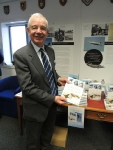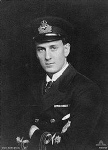Of cour se, not many squadrons reach their 100th year but, notwithstanding the imminent disbandment, what had been evident throughout the day, and very important to those Association members that had attended, was the exceptional spirit of the Squadron, which was something that had endured throughout its history, as Graham Pitchfork’s new book ‘Forever Vigilant’ could attest. It made the President and the assembled Association members extremely proud to share, once again, in 208 Squadron’s close-knit professionalism, camaraderie and ‘banter’ that had always been its trademark, and he congratulated the current Squadron Commander, Wing Commander Chris Kidd, not just for maintaining that tradition amongst the Squadron staff, but also for passing on such a fine and vital example to all of the RAF’s future combat pilots during its training role.
se, not many squadrons reach their 100th year but, notwithstanding the imminent disbandment, what had been evident throughout the day, and very important to those Association members that had attended, was the exceptional spirit of the Squadron, which was something that had endured throughout its history, as Graham Pitchfork’s new book ‘Forever Vigilant’ could attest. It made the President and the assembled Association members extremely proud to share, once again, in 208 Squadron’s close-knit professionalism, camaraderie and ‘banter’ that had always been its trademark, and he congratulated the current Squadron Commander, Wing Commander Chris Kidd, not just for maintaining that tradition amongst the Squadron staff, but also for passing on such a fine and vital example to all of the RAF’s future combat pilots during its training role.
The President recalled that the original Squadron spirit and its  enduring standards had been set by its first Commanding Officer, Sir Geoffrey Bromet a hundred years ago. Putting the Squadron’s formation into a modern ‘joint’ context, it had been formed after a request to the Admiralty from
enduring standards had been set by its first Commanding Officer, Sir Geoffrey Bromet a hundred years ago. Putting the Squadron’s formation into a modern ‘joint’ context, it had been formed after a request to the Admiralty from  Field Marshal Haig and General Trenchard to form additional scout squadrons for reconnaissance following the battles on the Western Front after the Somme. Those who had read the book ‘Naval Eight’ will know how Bromet inspired the Squadron by setting extraordinary standards and working diligently to ensure that it survived the most testing conditions of the First World War. The Squadron had taken part in dogfights with the Richthofen ‘Circus’, had some 25 ‘Aces’ and the Australian Robert Little, one of its Flight Commanders’ has been credited with some 47 ‘kills’. In all, a remarkable history for the Squadron to be proud of.
Field Marshal Haig and General Trenchard to form additional scout squadrons for reconnaissance following the battles on the Western Front after the Somme. Those who had read the book ‘Naval Eight’ will know how Bromet inspired the Squadron by setting extraordinary standards and working diligently to ensure that it survived the most testing conditions of the First World War. The Squadron had taken part in dogfights with the Richthofen ‘Circus’, had some 25 ‘Aces’ and the Australian Robert Little, one of its Flight Commanders’ has been credited with some 47 ‘kills’. In all, a remarkable history for the Squadron to be proud of.
Naval Eight became 208 Squadron in the April of 1918 when the Royal Air Force was formed and, because of his affection and respect for the Squadron, Trenchard (the father of the Royal Air Force) specifically chose 208 to survive the great demobilisation at the end of the War. Such are the vagaries of how disbandments and reformations are decided. Thereafter, the Squadron served continuously for 51 years overseas in reconnaissance duties through West Africa and the Middle East before being disbanded for 3 years at the end of the Hunter era. It was reformed again in 1974 with the mighty Buccaneer, which meant that the Squadron was, for the first time in 51 years, based in the UK, firstly at Honington and then at Lossiemouth, serving with great distinction in the Gulf War before the Buccaneer was finally withdrawn from service.
And then to Valley for 22 years, and the President gave credit to the Squadron for maintaining the utmost standards and producing the exceptional quality of pilots required on the front line, both for the UK and for other nations, right up to the end.









